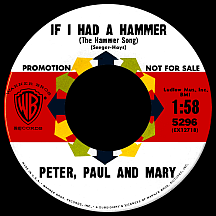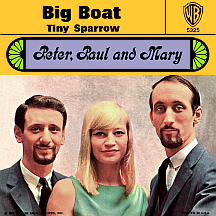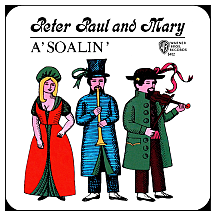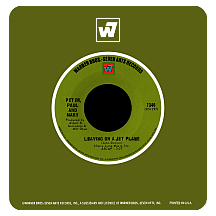PETER, PAUL AND MARY
Albert Grossman was the guy who took three relatively inexperienced singers and helped them navigate the viciously unforgiving atmosphere of New York City as a collective unit, shaping them within a matter of months into a fully-formed folk act much greater than the sum of its separate identities. Timing, of course, was a major factor; had folk music not been so magnificently in vogue during the early 1960s, Peter, Paul and Mary might have been little more than an entertaining coffee-house act catering to a cult following perplexed by their obscure standing. But by an unusual set of circumstances they were able to chart their own course, in the process outlasting music's "folk boom" phase without having to adapt to any evolving trends outside a collective comfort zone...except by choice, that is. This beguiling blonde flanked by two bearded guys appeared as a compelling alternative to folk superstars The Kingston Trio and delivered nearly a decade of artistic consistency and exceptional commercial success followed by intermittent collaborations embraced by avid fans.
The Chicago-born Grossman established himself in New York during the early '60s as a musician's manager who made things happen for his clients, though his methods often rubbed outsiders the wrong way. These three individually gravitated toward the exciting Greenwich Village scene. Noel Paul Stookey was born in Baltimore, Maryland and spent his teenage years in the Detroit suburb of Birmingham, Michigan. A fan of R&B, doo wop and rock and roll, he formed Noel Stookey and his Corsairs in 1956 when he was 18; the guitarist and singer led the fledgling rock band that consisted of saxophonist Mike Weston, bassist Jim Ewing and drummer Tom Halstead. In '57 they recorded two tracks Stookey had written, "Ivy Covered Castle" and "Goodbye Baby," paying to have a small quantity of 45s pressed on Shadow, a label made up for this singular purpose. Moving to N.Y. a few years later, he found work in the Village doing standup comedy at the Gaslight Cafe in addition to singing gigs.
Peter Yarrow was born and raised in Manhattan, giving him an advantage when he began breaking into the business during the late '50s. A lucky break came with his appearance on a special edition of CBS-TV's Spring Festival titled Folk Sound U.S.A., which aired Thursday, July 16, 1960. In a format producer Robert Herridge called "impressionistic," the show was staged with no sets and featured performances by bluegrass stars Lester Flatt and Earl Scruggs, bluesman John Lee Hooker and folk singers Cisco Houston, John Jacob Niles, Casey Anderson and Joan Baez, the "teen-ager" of the bunch, as that week's TV Guide was quick to point out. For most of these artists it was their first appearance on a nationally-televised program; it raised Yarrow's profile considerably, leading to a spot at the Newport Folk Festival in June.
Mary Travers of Louisville, Kentucky arrived in New York with the least experience of the three, seeing as how her parents moved into the Greenwich Village neighborhood shortly before her second birthday. As a teen she sang with The Song Swappers, a group that backed some of Pete Seeger's recordings in the mid-'50s. In April 1958, Mary had a small role as a folk singer in the Broadway musical The Next President (starring Mort Sahl, it also featured future Rooftop Singer Erik Darling), which closed after 13 performances.
Taking note of their raw talent and seeing in them a potential to complement one another, Mr. Grossman became their manager and insisted they needed a lot of practice. He hired Milt Okun (a former member of American folk group The Skifflers and a key figure in the late-'50s success of Harry Belafonte) to work with them, but Milt initially lacked faith in the act's ability to perform at anything approaching a professional level. In throwing around possible names for the act, Grossman came up with The Willows (there was already a doo wop Willows they probably hadn't heard of), but "Peter, Paul and Mary" had a nice ring to it, provided Noel was willing to use his middle name (Peter, Noel and Mary...could it have worked?), which he had no problem with, as many acquaintances had struggled with the correct pronunciation of his first name.
After several months of rehearsals, the three debuted in front of an audience at Folk City, a popular Village nightclub; Peter had been performing there and did his regular act, Paul did some comedy, Mary joined them and they all sang together but weren't identified under any particular group name. Mary was extremely nervous onstage (and for some time afterwards) and never spoke during early performances (it was Grossman's idea that she convey a little mystique, letting the guys do the talking); eventually loosening up, she held her own with both of them. Two weeks later they appeared as full-fledged folk act Peter, Paul and Mary at Fred Weintraub's Bitter End, a soon-to-be-famous showcase for talent that had opened that summer in Greenwich Village.
Grossman was determined to get the trio signed to a major label, nothing less than a difficult task. Folk-oriented companies like Verve and Vanguard would have likely been a good fit, but aggressive Albert was shooting for something more mainstream like the success of the Kingston Trio at Capitol and The Brothers Four at Columbia. In talking to reps from those companies and RCA (its top folk act was The Limeliters), they experienced a disconnect with each for various reasons. So they looked into the three-year-old Warner Bros., at one point a low-priority branch of WB Pictures, though the company's profile had ticked up a few notches with its acquisition of The Everly Brothers the previous year and a million-selling comedian, Bob Newhart, whose Button Down Mind of... album had been dominating the charts. PP&M and Grossman made the trek to the west coast, a world apart from NYC, where the record label was operating out of several shabby bungalows adjacent to the Warner movie lot.
Coming on strong with a little fast talk, Grossman basically offered WB a cheap one-album deal on the trio, but with a signed agreement that, should the initial effort fail, the group would go their merry way and the record company would get off easy, but should it be successful, the three would have carte blanche on choice of music, cover art and a free pass should they develop bloated egos (which didn't happen)...plus a healthier-than-industry-standard percentage of the profits. Amazingly, the semi-desperate WB took the bait and in January 1962 the trio set about recording the all-important longplay debut. Around the same time, 20-year-old Minnesotan Bob Dylan was busy in the Big Apple putting together his first album for Columbia Records. Later, he and PP&M would be connected in a way that would greatly benefit them all.
"Lemon Tree," probably the most famous creation of singer-songwriter Will Holt, takes the odd point of view that the lemon '...is impossible to eat.' This thought-provoking ditty was the first single for Peter, Paul and Mary and served as a solid debut that made the top 40 in June '62. "If I Had a Hammer" had been penned by Pete Seeger and Lee Hays of the top folk act of the '50s, The Weavers, who recorded it in 1950 as "The Hammer Song." Though originally an edgy political statement (the hammer referring to the "red scare" of the post-war 1940s), the Peter, Paul and Mary remake had a more positive feel ('...it's the hammer of justice...it's the bell of freedom...') and it landed them in the top ten for the first time that October. Both songs were from the album that the Warners deal had hinged on; the self-titled debut went far beyond expectations, spending more than three years on the album charts, hitting number one in October 1962 and impressively returning to the top spot a full year later.
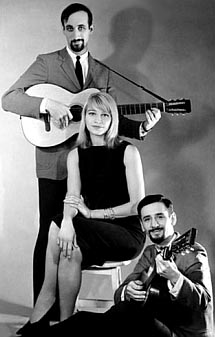
As unlikely as it might have seemed to Yarrow, Stookey and Miss Travers just a year earlier, Grammy time rolled around and in May 1963 they became the recipients of two awards (Best Performance by a Vocal Group and Best Folk Recording, both for "If I Had a Hammer"), plus a nomination for Best New Artist (Broadway star Robert Goulet was the winner). The second album, (Moving), was already high on the charts by that time, though the set's first two singles had failed to catch on like the previous hits. "Big Boat" was credited to writers Stookey and Elaina Mezzetti, though the actual composer was Elaina's brother, Peter Yarrow (he admitted giving her credit for a few of his songs so she would have some added income). "Settle Down" was penned by Mike Settle (a member of The New Christy Minstrels, he once had his own group, The Settlers, and obviously liked hearing his own name!).
The next single was based on a poem written a few years before by college student Lenny Lipton and became a surprise smash that took PP&M to an even higher level of popularity; "Puff (The Magic Dragon)," a children's tale about the fictional Jackie Paper's imaginary friend who sadly disappears when the child reaches a certain age, hit number two on the national charts in May 1963, becoming a standard known by just about everyone, particularly after a Newsweek magazine article ran the following year claiming "Puff" was about smoking marijuana. Yarrow has denied that theory ever since, saying it was simply about a child's imagination and the inevitable loss of innocence.
Mary and her partners Peter and Paul had been friends with Bob Dylan ever since they'd made the Greenwich rounds, impressed with his creative ability from the start. The trio recorded "Blowin' in the Wind," a mildly pessimistic contemplation on civil rights ('How many roads must a man walk down...before they call him a man?...How many years can some people exist...before they're allowed to be free?...The answer, my friend, is blowin' in the wind...') filled with questions still in search of answers. Dylan's important composition reached a large audience through Peter, Paul and Mary's version, a number two hit (just like the previous single) in August. For the second straight year, the group won Grammys in the categories Best Performance by a Vocal Group and Best Folk Recording, this time for the brilliant "Blowin'."
Meanwhile, Latin artist Trini Lopez lit up the crowds at PJ's nightclub in Hollywood and scored a major hit with his energetic live version of "If I Had a Hammer," making a kindred connection with PP&M (Mary has said they sometimes sang "Hammer" Trini-style if they felt the audience would react better to it that way). A couple of years later, Lopez scored with "Lemon Tree," a rare case of artists having two hit songs in common. Then the polyandrously platonic three had their second hit in a row with a Bob Dylan song: "Don't Think Twice, It's All Right" had appeared on The Freewheelin' Bob Dylan in the spring (as had "Blowin' in the Wind") and a cover was released on Atlantic around that time by The New World Singers featuring Gil Turner, but it was PP&M's version that shined, becoming the trio's fourth top ten hit in November '63. "Stewball," based on an 1820s song about a racehorse, originally titled "Skewbald," added to the group's string of top 40 hits at the end of the year.
The group's third 33-and-a-third, In the Wind, contained poetically abstract liner notes by Bob Dylan ("For Peter's grown an Paul's grown an Mary's grown an the times've grown") and shot to number one shortly after its October release; for several weeks the first three albums were in the top ten simultaneously; Peter, Paul and Mary were ranked by Billboard magazine as the number one album artists of 1963. A track from (Moving), "A-Soalin'," was issued as a seasonal single and reached Billboard's special Christmas charts. Live performances often included comedy bits by the group and occasional audience participation; "Oh, Rock My Soul" is one example, part of the group's top-selling double-disc In Concert LP from 1964.
John Court's liner notes for the 1965 album A Song Will Rise gave a four-years-on update, providing a glimpse for fans of their beloved trio's personal lives. Info on Peter wasn't too specific: "There is painting and pouting and laughing and thinking and understanding acutely...enjoying the physical life and all things beautiful (animal, vegetable, mineral), combined with more thinking, thinking, thinking..." As for Paul: "Mr. Stookey has as his pride a wife. An exceptional Betty...who is going to have a son on the 10th of May...the pet Jaguar they keep in the garage is sick of a cracked block from want of a drink of anti-freeze. Too bad, pet Jaguar, you are about to become number-two favorite in any case." And he gave us this on the blonde beauty: "And as for the married Mary, she's as merry a married Mary as might be. In those big blue eyes we see reflected that vamp of an elfin daughter. Inquisitive Erika is the shortcake in mother's lavish diet...Mary's mister, Barry...has charm with a fast valve on it, a Porsche, a motorcycle and a greater appetite for fun than this world can face without a blush." The LP contained the appealingly harsh (if such a thing exists, this is it) "For Lovin' Me" (as in 'That's what'cha get...'), a top 30 hit in February 1965 (and a breakthrough for Ontarian singer-songwriter Gordon Lightfoot), in addition to the by-now-obligatory Dylan tune, "When the Ship Comes In," a swashbucklingly adventurous musical story with a twist ending.
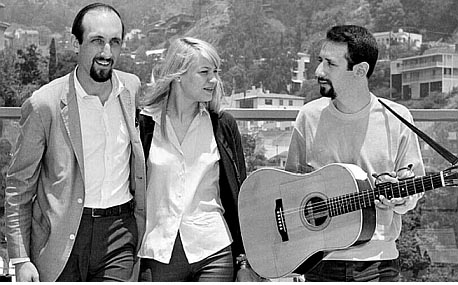
Peter, Paul and Mary didn't seem to have a problem holding their own in the British rock/American folk-rock scene of the mid-'60s while resisting any temptation to play by the latest set of rules...well, at least for the time being. So is it true The Beatles called them "Pizza, Pooh and Magpie"? A criticism? Or just affectionate nicknames as Johnny and the Moondogs were wont to bestow on those they were fond of? The trio finally gave a nod to the '60s rock movement on the lead single from Album 1700 (which used the WB catalog number as its title); "I Dig Rock and Roll Music" played as a tongue-in-cheek tribute to The Mamas and the Papas, Donovan and the Beatles representing the R&R elite. The novelty track even used a "backmasking" effect during its passage concerning the recently-psyched-out Fab Four. Reactions were unrelenting. Critics of the day bristled. But radio embraced it and in the Sgt. Pepper summer of '67 the song made its way to the top ten, PP&M's first in almost four years.
"Too Much Of Nothing" offered '...my salary...on the waters of oblivion' to anyone named Valerie or Marian, another of Dylan's offbeat puzzlers, delightfully rendered by folk's leading coed trio. Peter Yarrow indulged in a side project, composing music for the soundtrack of a bizarre documentary, You Are What You Eat; "Don't Remind Me Now of Time" was a solo single from the film but, unlike nearly every one of the group's singles, it failed to make the charts. 1969 turned out to be a strong year for the act; prolific producer Phil Ramone helmed the recording of Yarrow's father-to-son narrative "Day is Done," a top 30 hit in May and June (Grossman and Okun had produced nearly everything else the trio had done). At the end of the year a two-year-old Album 1700 track, "Leaving on a Jet Plane," gave the group the elusive number one hit they'd come so close to in the past; its popularity put songwriter John Denver on the radar and paved the way for a long string of hits for the New Mexican singer so fond of the Rocky Mountains.
In the fall of 1970 the group announced they would be taking a year off to work on other projects. In the spring of '71, Mary Travers released her solo album, Mary, with a plain yellow cover showing her name taken straight from the group's logo; her version of Denver's "Follow Me" was a minor, but memorable, hit. Paul Stookey's solo disc came out a few months later; Paul and had a solid blue background and the middle two words of the PP&M logo. "Wedding Song (There is Love)" was a top 40 hit and predictably became an extremely popular song at weddings; he had initially composed it for Peter's 1969 vow-exchanging ceremony. As for Peter Yarrow, in early 1972 he finally finished his own solo effort, Peter (the last piece of the logo with a brown background...collect them all!); the solo albums had come out in reverse order of billing...gotta love it. The one-year break extended into eight; Peter, Paul and Mary reunited for the first time in 1978 and worked together on and off for another three decades.
NOTABLE SINGLES:
- Ivy Covered Castle - 1957
by Noel Stookey and his Corsairs - Lemon Tree - 1962
- If I Had a Hammer (The Hammer Song) - 1962
- Big Boat - 1962
- Settle Down (Goin' Down That Highway) /
500 Miles - 1962 - Puff (The Magic Dragon) - 1963
- Blowin' in the Wind - 1963
- Don't Think Twice, It's All Right - 1963
- Stewball - 1963
- A'Soalin' - 1963
- Tell it on the Mountain - 1964
- Oh, Rock My Soul - 1964
- For Lovin' Me - 1965
- When the Ship Comes In - 1965
- Early Morning Rain - 1965
- The Cruel War - 1966
- The Other Side of This Life - 1966
- Hurry Sundown - 1967
- I Dig Rock and Roll Music - 1967
- Too Much of Nothing - 1967
- Don't Remind Me Now of Time - 1968
by Peter Yarrow - Day is Done - 1969
- Leaving on a Jet Plane - 1969
- Follow Me - 1971
by Mary Travers - Wedding Song (There is Love) - 1971
by Paul Stookey - Don't Ever Take Away My Freedom - 1972
by Peter Yarrow


